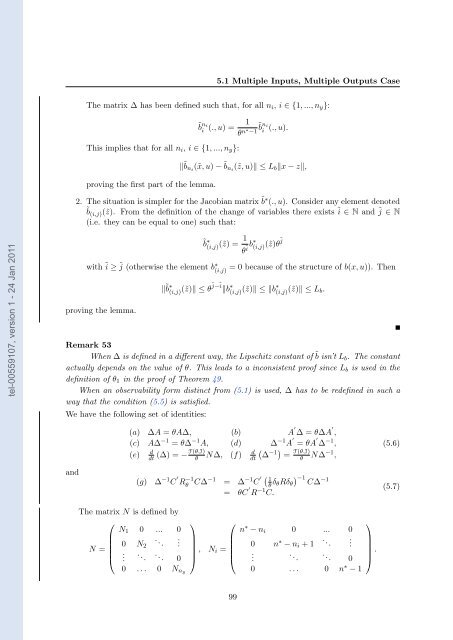Adaptative high-gain extended Kalman filter and applications
Adaptative high-gain extended Kalman filter and applications
Adaptative high-gain extended Kalman filter and applications
You also want an ePaper? Increase the reach of your titles
YUMPU automatically turns print PDFs into web optimized ePapers that Google loves.
tel-00559107, version 1 - 24 Jan 2011<br />
5.1 Multiple Inputs, Multiple Outputs Case<br />
The matrix ∆ has been defined such that, for all ni, i ∈ {1, ..., ny}:<br />
This implies that for all ni, i ∈ {1, ..., ny}:<br />
proving the first part of the lemma.<br />
˜ni 1<br />
bi (., u) =<br />
θn∗−1 ˜b ni<br />
i (., u).<br />
� ˜ bni (˜x, u) − ˜ bni (˜z, u)� ≤Lb�x − z�,<br />
2. The situation is simpler for the Jacobian matrix ˜ b ∗ (., u). Consider any element denoted<br />
˜ b(i,j)(˜z). From the definition of the change of variables there exists ĩ ∈ N <strong>and</strong> ˜j ∈ N<br />
(i.e. they can be equal to one) such that:<br />
˜ b ∗ (i,j) (˜z) = 1<br />
θ ĩ b∗ (i,j) (˜z)θ˜j<br />
with ĩ ≥ ˜j (otherwise the element b∗ (i,j) = 0 because of the structure of b(x, u)). Then<br />
proving the lemma.<br />
�˜b ∗ (i,j) (˜z)� ≤θ˜j−ĩ ∗<br />
�b(i,j) (˜z)� ≤ �b ∗ (i,j) (˜z)� ≤Lb.<br />
Remark 53<br />
When ∆ is defined in a different way, the Lipschitz constant of ˜ b isn’t Lb. The constant<br />
actually depends on the value of θ. This leads to a inconsistent proof since Lb is used in the<br />
definition of θ1 in the proof of Theorem 49.<br />
When an observability form distinct from (5.1) is used, ∆ has to be redefined in such a<br />
way that the condition (5.5) is satisfied.<br />
We have the following set of identities:<br />
<strong>and</strong><br />
(a) ∆A = θA∆, (b) A ′<br />
∆ = θ∆A ′<br />
,<br />
(c) A∆−1 = θ∆−1A, (d) ∆−1A ′<br />
= θA ′<br />
∆−1 ,<br />
d<br />
F(θ,I)<br />
(e) dt (∆) =− θ N∆, (f) d<br />
dt<br />
(g) ∆ −1 C ′<br />
R −1<br />
θ C∆−1 = ∆ −1 C ′ � 1<br />
� ∆ −1 � = F(θ,I)<br />
θ N∆−1 ,<br />
θ δθRδθ<br />
= θC ′<br />
R−1C. � −1 C∆ −1<br />
The matrix N is defined by<br />
⎛<br />
N1<br />
⎜<br />
N = ⎜ 0<br />
⎜<br />
⎝ .<br />
0<br />
N2<br />
. ..<br />
...<br />
. ..<br />
. ..<br />
0<br />
.<br />
0<br />
⎞<br />
⎟<br />
⎠<br />
0 . . . 0 Nny<br />
, Ni<br />
⎛<br />
n<br />
⎜<br />
= ⎜<br />
⎝<br />
∗ − ni<br />
0<br />
0<br />
n<br />
... 0<br />
∗ − ni +1 . .<br />
. ..<br />
. .<br />
. ..<br />
.<br />
0<br />
0 . . . 0 n∗ ⎞<br />
⎟<br />
⎠<br />
− 1<br />
.<br />
99<br />
(5.6)<br />
(5.7)

















